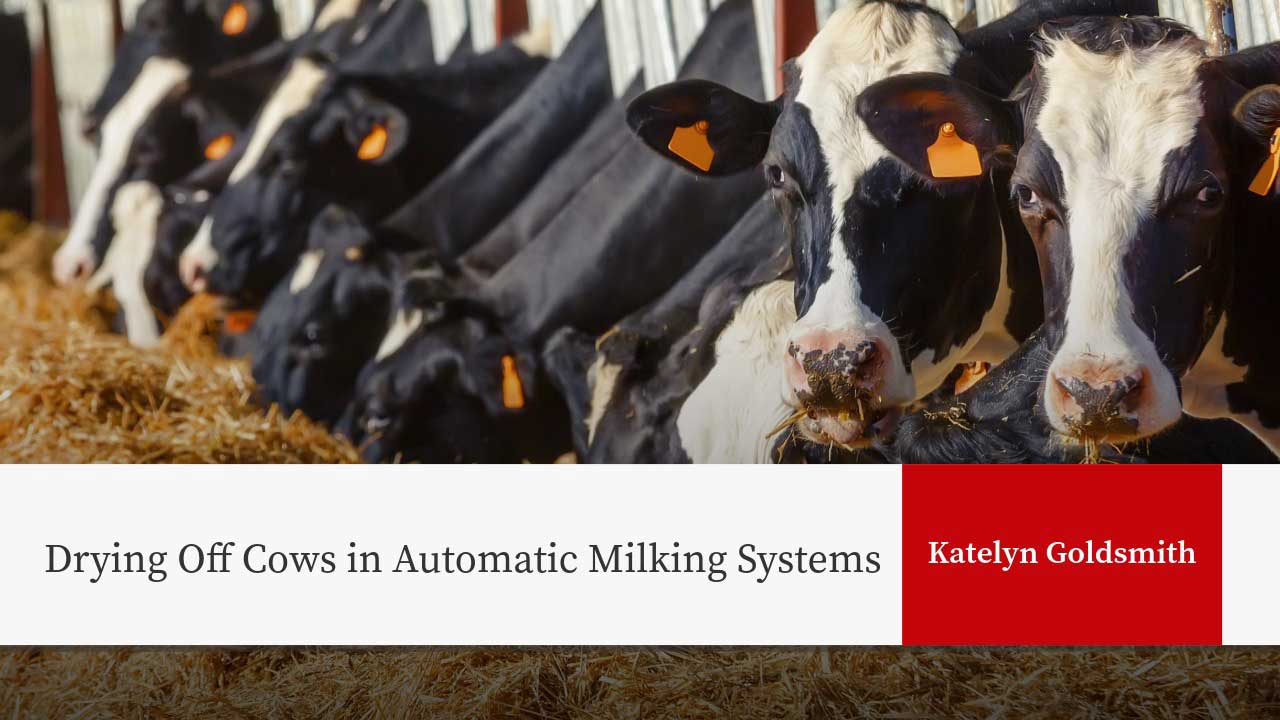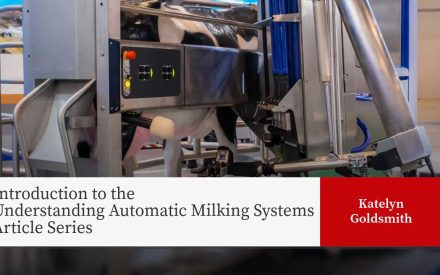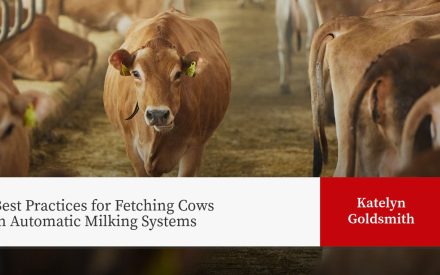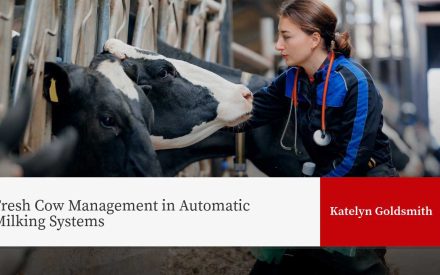
Introduction
Drying off dairy cows is a critical step in the lactation cycle that can have long-term effects on udder health and future milk production. This article will explore the primary strategies for drying cows off in Automatic Milking Systems (AMS) 🔍. Broadly, dry-off strategies fall into two categories: abrupt or gradual.
Abrupt Dry-Off
In an abrupt dry-off, cows are milked normally right up until the dry-off date, with no intentional reduction in milk yield or milking frequency prior to dry off. This method is commonly used for its simplicity and because it avoids potential losses in milk income leading up to dry-off due to purposely decreasing milk production.
However, research suggests that abrupt dry-off can increase the risk of milk leakage after dry-off (1). Cows producing higher levels of milk at dry-off are especially vulnerable. For instance, cows yielding more than 28 pounds at dry-off have been shown to be at increased risk of mastitis and elevated SCS (somatic cell score) in the next lactation (2,3,4). After abrupt dry-off, cows also show signs of udder engorgement and maintain the desire to be milked (5).
Gradual Dry-Off
A gradual dry-off involves practices to purposefully reduce milk production leading up to dry-off. Reducing milk production can promote the formation of the keratin plug in the teat canal which serves as a defense against bacteria during the dry period (6). It can also help minimize milk leakage, reduce udder pressure, and lower the risk of new mastitis infections during the dry period and early lactation (2).
In AMS herds, two common strategies are used to facilitate gradual dry-off:
- Reduce Milking Frequency: By adjusting milking permission 🔍 settings in the AMS software, farmers can limit how often a cow is allowed to be milked. Fewer milkings naturally lowers daily milk yield (5,7).
- Reduce Concentrate Allotment: The AMS concentrate serves as a source of energy to the cow. Reducing the allotment of AMS concentrate 🔍 not only lowers energy intake and therefore milk production potential, it may also reduce her incentive to visit the robot, further lowering milking frequency.
A research study showed that both strategies were effective in reducing milk yield in late-lactation cows managed with AMS (8). However, reducing milking permissions had a greater impact than adjusting concentrate on both milk yield and milking frequency.
The most significant impact was when these two strategies were combined. In the experiment, cows with reduced concentrate allowance and milking permissions decreased milk production by 10.8 lb per day while those with no change only decreased milk production by 6.2 lb/d (8).
Follow Best Practices at Dry-Off
Regardless of dry-off strategy, it is important that farms always follow proper application practices when administering intramammary treatments, such as internal teat sealants or antibiotic treatments. A clearly defined dry-off protocol helps ensure consistent management across the herd. Additionally, farms should select a location to dry-off cows that is both safe and hygienic, such as within the AMS or a chute.
Final Thoughts
Choosing the right dry-off strategy can have important impacts on cow health, welfare, and future productivity. Automatic milking systems offer routes, such as adjusting milking settings and feed allotment, to make gradual dry-off more manageable. Additionally, compared to parlor milking, AMS offers a unique opportunity to manage dry-off for individual cows. By leveraging these AMS capabilities, farms can enhance their dry-off management and set cows up for success.
For insights on what comes next, check out our article on managing fresh cows in AMS systems.
Author

Katelyn Goldsmith
Dairy Outreach Specialist– In her role as a statewide Dairy Outreach Specialist, Katelyn connects research with practical farm management practices to create educational programming addressing the needs of Wisconsin dairy producers.
Reviewers
References
- Zobel, G., Lesli, K., Weary, D.M., & von Keyserlingk, M.A.G. (2013). Gradual cessation of milking reduce milk leakage and motivation to be milked in dairy cows at dry-off. Journal of Dairy Science, 96:5064-5071. https://doi.org/10.3168/jds.2012-6501
- Pattamanont, P., Marcondes, M., & DeVries, A. (2020). Advantages and disadvantages of various dry-off methods for dairy cows. University of Florida IFAS Extension. Access online at https://journals.flvc.org/edis/article/view/115462/125012
- Cattaneo, L., Minuti, A., Dahl, G.E., & Trevisi, E. (2023). Graduate student literature review: The challenge of drying-off high yielding dairy cows. Journal of Dairy Science, 106:6416-6426. https://doi.org/10.3168/jds.2022-23113
- Gott, P.N., Rajala-Schultz, P.J., Schuenemann, G.M., Proudfoot, K.L., & Hogan, J.S. (2016). Effect of gradual or abrupt cessation of milking at dry off on milk yield and somatic cell score in the subsequent lactation. Journal of Dairy Science, 100:2080-2089. https://doi.org/10.3168/jds.2016-11444
- McGuire, E., Palle, R., Montes, M.E., Laporta, J., Dorea, J., Van Os, J., & Creutztinger, K. (2025). Easing the transition: Gradual vs. abrupt dry-off in an automatic milking system. Journal of Dairy Science, 108(Suppl. 1):366. Access online at https://www.adsa.org/Portals/0/SiteContent/Docs/Meetings/2025ADSA/Abstracts_BOOK_2025_20250624-1249.pdf
- Dingwell, R.T., Leslie, K.E., Schukken, Y.H., Sargeant, J.M., Timms, L.L., Duffield, T.F., Keefe, G.P., Kelton, D.F., Lissemore, K.D., & Conklin, J. (2004). Association of cow and quarter-level factors at drying-off with new intramammary infections during the dry period. Preventative Veterinary Medicine, 63:75-89. https://doi.org/10.1016/j.prevetmed.2004.01.012
- Stelwagen, K., Phyn, C.V.C., Davis, S.R., Guinard-Flament, J., Pomies, D., Roche, J.R., & Kay, J.K. (2013). Invited review: Reduced milking frequency: Milk production and management implications. Journal of Dairy Science, 96:3401-3413. https://doi.org/10.3168/jds.2012-6074
- France, A.E., Dufour, S., Kelton, D.F., Barkenma, H.W., Kurban, D., & DeVries, T.J. (2021). Effect of dry-off management on milking behavior, milk yield, and somatic cell count of dairy cows milked in automated milking systems. Journal of Dairy Science, 105:3544-3558. https://doi.org/10.3168/jds.2021-21383


 Introduction to the Understanding Automatic Milking Systems Article Series
Introduction to the Understanding Automatic Milking Systems Article Series Best Practices for Fetching Cows in Automatic Milking Systems
Best Practices for Fetching Cows in Automatic Milking Systems Fresh Cow Management in Automatic Milking Systems
Fresh Cow Management in Automatic Milking Systems ▶️ Watch: Asking the Right Questions Before Investing in Automation
▶️ Watch: Asking the Right Questions Before Investing in Automation


